Alopecia areata is an autoimmune disorder that causes hair loss on the scalp and other areas of the body. It affects people of all ages, genders, and races, and can range from a small patch of hair loss to complete baldness. While the exact cause of alopecia areata is unknown, it is thought to be caused by a combination of genetic and environmental factors.
Symptoms of Alopecia Areata
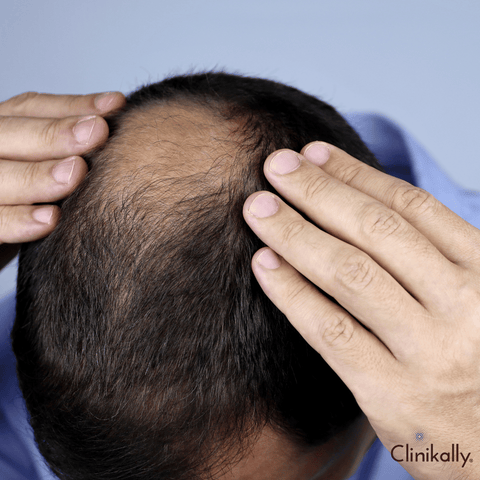
One type of hair loss known as alopecia areata usually manifests as abrupt, patchy hair loss. The illness can present with a variety of symptoms, which could include:
-
Sudden, patchy hair loss on the scalp or other areas of the body
-
Round or oval-shaped bald patches
-
Short, broken hair strands on the scalp
-
Itching or tingling sensation on the scalp
-
Nail changes, such as pitting, ridging, or thinning
If you're seeing any of these signs and are worried about it, you should consult a dermatologist who can look into your hair and scalp condition and provide a personalized treatment plan. At Clinikally, you can connect with a doctor and get an online dermatologist consultation at your chosen time and convenience, hassle-free.
Recognizing early signs of Alopecia Areata
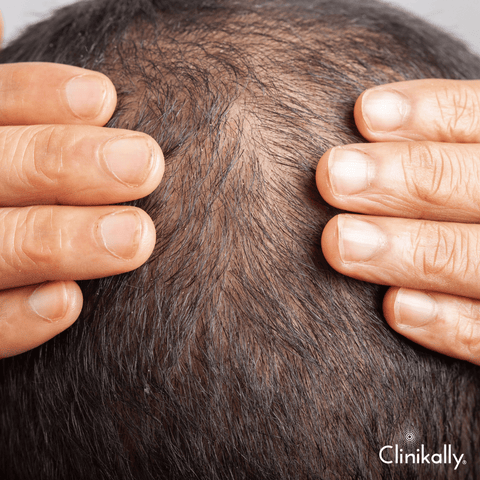
Being aware of changes in your hair and scalp can help you detect the early signs of Alopecia Areata. The following are some key signs and symptoms:
-
Patchy Hair Loss: Alopecia Areata is characterised by sudden and rapid hair loss in small, round patches on the scalp. These patches may be smooth, without scaling or redness, and vary in size.
-
Excessive Hair Shedding: Excessive hair shedding or clumps of hair falling out, especially when washing, brushing, or combing the hair, could be signs of Alopecia Areata in its early stages.
-
Hair Texture Changes: Some people may notice changes in the texture or quality of their hair in affected areas, such as thinning, becoming finer, or having a different hair colour or texture than the rest of their hair.
-
Scalp Sensitivity or Itching: In areas where hair loss is occurring, some people may experience sensations such as tingling, itching, or tenderness on the scalp.
-
Nail Changes: Pitting (little dents) or ridges may appear in the fingernails or toenails as a result of Alopecia Areata in certain cases. However, not everyone with Alopecia Areata will notice these changes in their nails.
-
Hair Loss Progression: Hair loss in Alopecia Areata can progress quickly and dramatically. Identifying early warning signs and seeking immediate medical attention can be critical for early intervention and treatment.
If you notice any of these signs or symptoms, especially sudden and unexplained hair loss in patches, you should see a dermatologist or other healthcare provider. Early detection and intervention can aid in the management of the condition and potentially improve the chances of hair regrowth. A dermatologist can make an accurate diagnosis and recommend treatments or therapies that are tailored to your specific situation.
Differentiating Alopecia Areata from other hair loss conditions
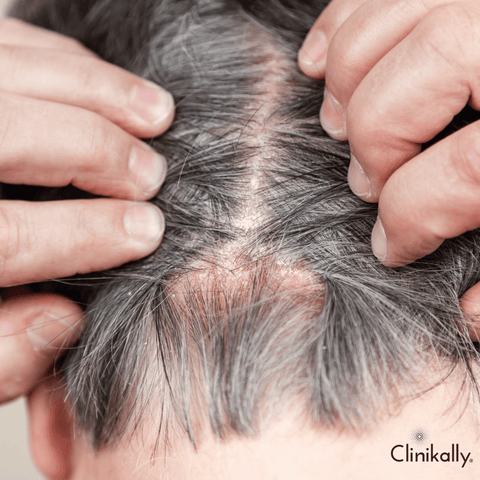
The pattern of hair loss, associated symptoms, and possible causes are some of the factors that should be considered to differentiate Alopecia Areata from other types of hair loss. Take into account the following information to assist you in distinguishing Alopecia Areata from other hair loss conditions:
Pattern of Hair Loss:
-
Alopecia Areata: Usually manifests as tiny, rounded patches of scalp hair loss. Hair loss may happen quickly and unexpectedly, and the patches may be smooth and well-defined.
-
Androgenetic Alopecia (Male/Female Pattern Baldness): This condition causes gradual hair thinning, primarily at the temples or crown of the head. It frequently follows a pattern, with hair becoming thinner and shorter.
Hair Loss Characteristics:
-
Alopecia Areata: This condition causes hair loss in discrete patches that are often smooth and without scaling. In some cases, regrowth may occur on its own.
-
Telogen Effluvium: Hair shedding is more diffuse and involves increased hair shedding across the scalp as a result of a triggering event such as stress, illness, or hormonal changes.
Associated Symptoms:
-
Alopecia Areata: Alopecia Areata does not usually cause itching, pain, or other skin changes in its classic form.
-
Scalp Conditions (e.g., Psoriasis, Seborrheic Dermatitis): Hair loss may be accompanied by redness, scaling, itching, or irritation of the scalp.
Age of Onset:
-
Alopecia Areata: This condition usually begins in childhood or early adulthood, but it can occur at any age.
-
Androgenetic Alopecia: Androgenetic Alopecia usually appears later in life, more commonly in middle-aged or older people.
Family History:
-
Alopecia Areata: A family history of autoimmune diseases or Alopecia Areata may increase the risk, but it is not always present.
-
Androgenetic Alopecia: Has a strong genetic component, and pattern hair loss runs in families.
Nail Changes:
-
Alopecia Areata: Some people may notice changes in their fingernails or toenails, such as pitting or ridges.
-
Other Conditions: Nail changes are not always associated with other types of hair loss.
Medical Evaluation:
-
A dermatologist or other healthcare professional can perform a thorough examination, review your medical history, and possibly perform additional tests or biopsies to confirm or rule out other conditions.
The best course of action for the management and treatment of hair loss must be decided after accurately classifying the type of hair loss. Consulting with a dermatologist or other healthcare provider can help determine the best course of action for treating hair loss or changes in the hair and scalp.
Causes of Alopecia Areata

An autoimmune disorder called alopecia areata causes hair loss, usually in small, circular areas on the scalp, though it can also affect hair on other parts of the body. Although the precise aetiology of alopecia areata is unknown, several variables are thought to be involved with its development:
-
Genetics: Alopecia areata tends to run in families, suggesting a genetic component to the disorder.
-
Environmental triggers: Some people with alopecia areata report that a stressful event or illness caused their hair loss.
-
Immune system dysfunction: Alopecia areata is an autoimmune disorder, meaning that the body's immune system mistakenly attacks healthy cells. In the case of alopecia areata, the immune system attacks the hair follicles, causing hair loss.
It's crucial to remember that alopecia areata varies substantially from person to person and that the precise mix of factors influencing its development might also vary. Furthermore, the disorder can cause more significant hair loss or persistent patterns of hair loss, which may call for medical attention, as well as smaller patches of hair loss that regenerate on their own. Speaking with a dermatologist or other medical expert can help determine the best course of action for treating alopecia areata based on each patient's unique needs.
What is the main cause of Alopecia Areata?
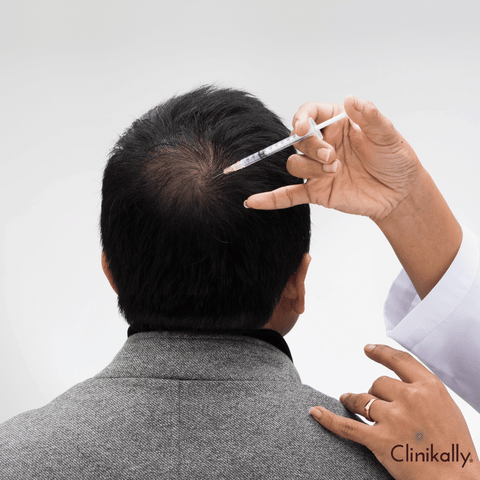
The exact cause of alopecia areata is not fully understood, but it is believed to be a combination of genetic and environmental factors. Some research suggests that alopecia areata is caused by a combination of genetic susceptibility and environmental triggers such as stress or illness.
Genetic factors in Alopecia Areata
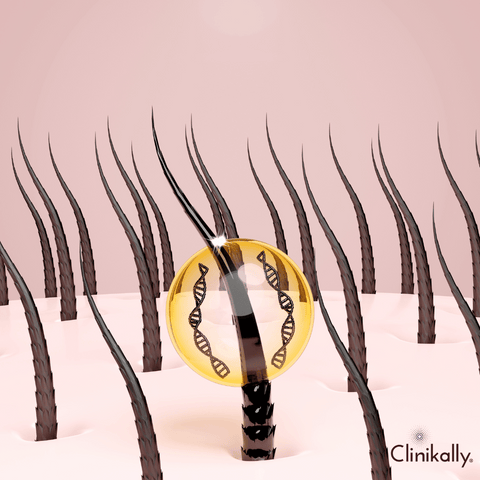
Alopecia Areata, an autoimmune disorder that causes hair loss, does have a genetic component, though the precise genetic factors involved are complex and not fully understood. The following are some key points about the role of genetics in Alopecia Areata:
-
Family History: Those who have alopecia areata in their family are more likely to get the disorder themselves. It is typical for those who are impacted to have parents, siblings, or even extended family members who have or have had Alopecia Areata.
-
Genetic Predisposition: Alopecia Areata is one autoimmune disease that is susceptible to genetic predisposition. There are several genetic factors thought to play a role in the condition's development.
-
Polygenic Inheritance: Multiple genes, as opposed to one, influence Alopecia Areata, making it a polygenic disease. It develops as a result of interactions between different genes and environmental cues.
-
HLA Genes: Variations in the immune system-related human leukocyte antigen (HLA) genes have been linked to a higher risk of developing alopecia areata. All those with these variations do not, however, go on to acquire the illness.
-
Complex Interactions: Immune system genes, along with other genetic and environmental factors, interact intricately in the genetic predisposition to Alopecia Areata. Immunological, environmental, and genetic factors all play a role in this complex disease.
-
Epigenetic Factors: Stressors or causes in the environment can affect Alopecia Areata by causing variations in gene expression without altering the underlying DNA sequence.
It is crucial to keep in mind that, although genetics plays a role in the development of Alopecia Areata, not everyone with a genetic predisposition will necessarily develop the condition. Triggers like immune system dysregulation, stress, and environmental factors also affect the development and course of Alopecia Areata. Comprehending the genetic foundation of Alopecia Areata could lead to progress in pinpointing possible therapeutic targets and customised treatment methods. Still, further investigation is required to completely understand the complex genetic pathways causing the illness.
Environmental triggers of Alopecia Areata

Alopecia areata is an autoimmune illness that results in hair loss. It is believed that a combination of immune system dysfunction, environmental factors, and genetic predispositions produce this disorder. It is thought that a variety of environmental conditions might cause alopecia areata, while the precise cause is yet unknown. Among them are:
-
Stress: Stressful situations, traumatic experiences, or elevated emotional stress can cause or worsen episodes of Alopecia Areata. Stress can affect the immune system, which might result in autoimmune reactions.
-
Illness or Infections: In susceptible people, certain illnesses, infections, or immune system problems, such as bacterial or viral infections, may function as triggers for alopecia areata. The immune response in these circumstances may set off an autoimmune reaction that attacks hair follicles.
-
Hormonal Changes: Alopecia Areata may develop or worsen depending on fluctuations in hormone levels, which can occur during puberty, pregnancy, childbirth, or menopause. Hormonal fluctuations can impact the immune system and possibly lead to hair loss.
-
Trauma or Injury: Alopecia Areata may develop in certain people as a result of physical trauma, surgery, or injuries to the skin, including the scalp. This is referred to as the "Koebner phenomenon," in which skin injuries cause skin conditions to develop.
-
Allergens and Chemical Exposures: For those who are susceptible, exposure to specific allergens, chemicals, or environmental pollutants may cause or worsen alopecia areata. For example, hair dyes or products may irritate.
-
Medication: In certain patients, Alopecia Areata may occur as a side effect of certain medications or treatments. That being said, this is not very common.
-
Psychological Factors: Anxiety and depression are two psychological factors that may have an impact on the development or aggravation of alopecia areata. Mental health issues and emotional stress can have an impact on how the immune system functions.
Because Alopecia Areata triggers vary from person to person and some may not have the same effect on everyone, it can be challenging to identify specific triggers. Furthermore, although these factors may have a role in the development or exacerbation of Alopecia Areata, they are not necessarily responsible for all cases of the disorder. Alopecia Areata patients can better control their condition by minimising exposure to known triggers and putting stress-reduction techniques into practice. Further research is required to fully understand the relationship between environmental triggers and the start of alopecia areata.
Types of Alopecia Areata
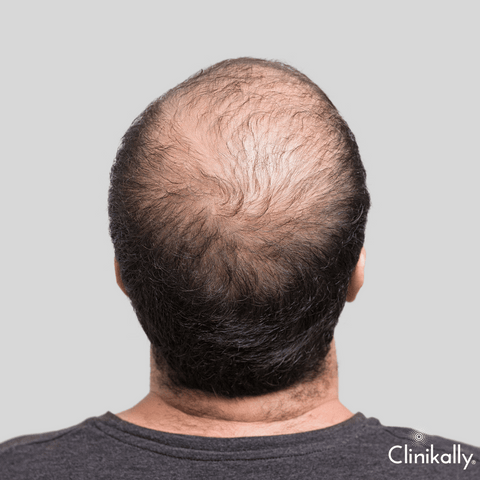
Alopecia areata is a kind of hair loss that can appear in different ways and to different extents. The following are the various forms of alopecia areata:
-
Patchy alopecia areata: As the name suggests, this type of alopecia areata is characterised by one or more round or oval-shaped bald patches on the scalp or other areas of the body.
-
Alopecia totalis: This type of alopecia areata is characterised by complete baldness on the scalp.
-
Alopecia universalis: This is the most severe form of alopecia areata, and is characterised by complete baldness on the scalp and other areas of the body.
While these are recognised forms of alopecia areata, it's vital to remember that people who have the disorder may eventually advance from one kind to another or suffer overlapping patterns. Individual differences exist in the progression and severity of alopecia areata, as well as the type and degree of hair loss affected by the condition and how it is treated. To receive a precise diagnosis and a customised treatment plan that addresses each patient's unique condition, speaking with a dermatologist or other healthcare provider is imperative.
Classifying different forms of Alopecia Areata

Alopecia areata is a condition characterised by sudden, uneven hair loss. There are several acknowledged kinds or variations of Alopecia Areata, depending on the pattern and severity of hair loss. These formats include:
-
Localised Alopecia Areata: This type of condition usually shows up as one or more small, rounded patches of scalp hair loss. The patches can vary in size and are typically clearly defined. Hair regrowth can occur without treatment in many cases.
-
Alopecia Totalis: Alopecia Totalis is characterised by extensive hair loss on the scalp, resulting in total baldness of the scalp area. It differs from localised Alopecia Areata in that it causes widespread hair loss throughout the scalp.
-
Alopecia Universalis: The most severe form of Alopecia Areata, this condition causes total hair loss not only on the scalp but also on other parts of the body, including the eyebrows, eyelashes, beard, and body hair.
-
Ophiasis Pattern: Ophiasis pattern Alopecia Areata is distinguished by a band-like pattern of hair loss that typically occurs along the sides and back of the scalp. The term "ophiasis" is derived from the Greek word for "snake," and refers to the snake-like pattern of hair loss.
-
Diffuse Alopecia Areata: Hair loss occurs diffusely across the scalp without distinct patchy areas in this variant. It can manifest as hair thinning or shedding without clearly defined patches.
-
Alopecia Areata Incognita: Alopecia Areata Incognita is characterised by sudden and rapid hair loss that does not manifest as bald patches. Instead, hair loss occurs in patches, making it difficult to diagnose at first.
-
Alopecia Areata Totalis Partialis: This term refers to the presence of both total hair loss over specific areas (totalis) and patchy hair loss (localised) in the same individual.
The degree and pattern of hair loss vary in these various kinds of Alopecia Areata, from sparse patches to total loss of body or scalp hair. Individual differences in the presentation of the disorder can be significant, and some people may eventually progress from one type to another. It is crucial to remember that Alopecia Areata is an illness that can differ from person to person in terms of progression and response to treatments. Speaking with a dermatologist or other medical expert can help determine the best course of action for managing the particular form of Alopecia Areata from which a person may be suffering.
Understanding patchy vs total hair loss in Alopecia
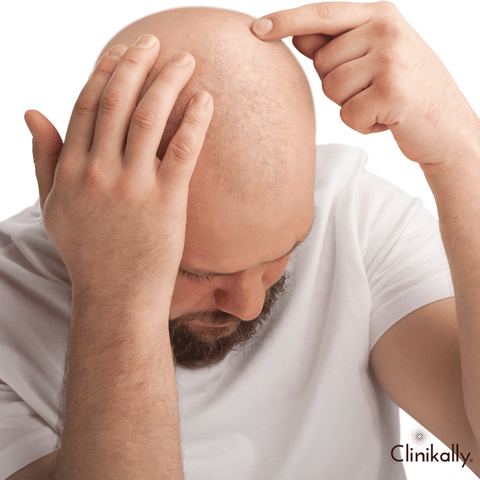
Understanding the differences between patchy and total hair loss in Alopecia Areata entails recognising the extent and pattern of hair loss in these variations of the condition:
Patchy Hair Loss (Localised Alopecia Areata):
-
Description: One of the main signs of Alopecia Areata is patchy hair loss. It is characterised by the sudden appearance of one or more small, round patches of hair loss on the scalp. These patches are typically well-defined, with sizes ranging from small coin-sized areas to larger patches.
-
Characteristics: Affected areas are typically smooth, with no visible scaling or irritation. Hair loss happens quickly, leaving bald spots on the scalp that may or may not grow larger over time.
-
Typical Presentation: The most prevalent type of alopecia areata is called localised alopecia, and it is typified by discrete areas of hair loss that, in certain circumstances, may sprout back naturally without the need for medical intervention.
Total Hair Loss (Alopecia Totalis and Universalis):
-
Alopecia Totalis: In this type, there is significant hair loss throughout the scalp, leading to total baldness. It is distinct from localised Alopecia Areata in that it affects the entire scalp, leaving no hair unaffected.
-
Alopecia Universalis: Alopecia Universalis is the most severe form, causing total hair loss not only on the scalp but also on other parts of the body such as the brows, eyelashes, beard, and body hair.
Key Differences:
-
Hair Loss Extent: Patchy hair loss (localised Alopecia Areata) causes hair loss in distinct, well-defined patches on the scalp. Total hair loss (Alopecia Totalis and Universalis) is characterised by widespread hair loss encompassing larger areas or the entire scalp as well as other body parts.
-
Regrowth Patterns: While total hair loss conditions frequently necessitate more intensive treatments and may have limited regrowth, patchy hair loss conditions may show spontaneous regrowth in some areas without treatment.
Transition Between Types: While some people with patchy Alopecia Areata may improve or spontaneously regrow hair in affected areas, others may develop more extensive forms, such as Alopecia Totalis or Universalis. The condition's course can change from person to person and can be unpredictable.
Knowing these differences can help diagnose and classify the type of Alopecia Areata a person is experiencing, directing management and treatment plans according to the degree and pattern of hair loss seen. A dermatologist or other healthcare provider should be consulted for an accurate diagnosis and customised treatment planning.
Alopecia Areata in women
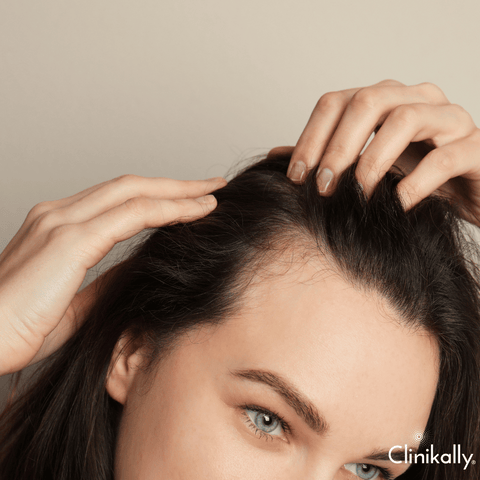
Alopecia areata affects both men and women, but it may be more noticeable in women due to societal expectations around hair. In women, alopecia areata can be particularly distressing due to the strong cultural associations with femininity and hair. However, it is important to remember that alopecia areata is not a reflection of one's worth or beauty as a person.
Unique challenges for women with Alopecia Areata
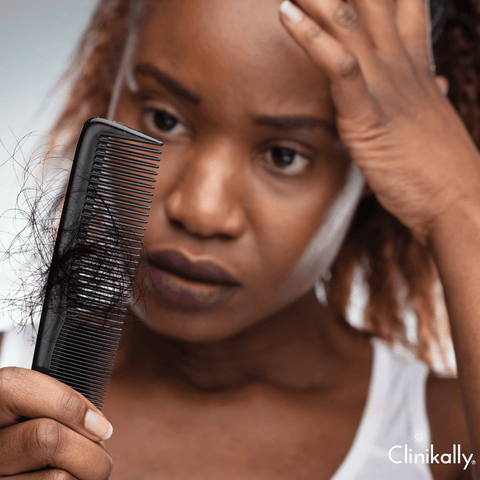
Women who have alopecia areata frequently deal with particular difficulties that might affect their emotional health, sense of self-worth, ability to communicate with others, and sense of self. The following are some particular difficulties that women with alopecia areata may face:
-
Social and Emotional Impact: A woman's confidence and sense of self-worth can be greatly affected by hair loss. Hair loss can cause feelings of embarrassment, self-consciousness, or anxiety in women because society places a high value on their appearance.
-
Identity and Femininity: Hair is frequently associated with femininity and beauty. Hair loss can have an impact on a woman's sense of identity and femininity, causing feelings of loss, grief, or a shift in self-perception.
-
Impact on Relationships: Coping with hair loss can have an impact on relationships, including romantic relationships, friendships, and interactions in social settings. Women may be self-conscious or concerned about how others perceive them.
-
Challenges in Professional Settings: Some women may face difficulties in professional settings where appearance is valued. Coping with hair loss at work may cause concerns about judgement, discrimination, or self-confidence in the workplace.
-
Psychosocial Distress: Alopecia Areata can cause significant psychosocial distress in affected individuals, resulting in emotional stress, anxiety, depression, or a decreased quality of life.
-
Treatment Obstacles: Some hair regrowth or management treatments may require different considerations or be less effective in women than in men. The visibility of hair loss can also make managing styling or concealing techniques difficult.
-
Limited Treatment Options: Despite ongoing research, effective and dependable treatments that guarantee consistent regrowth for Alopecia Areata are scarce. The lack of definitive treatment options can be frustrating and disheartening for women looking for answers.
-
Support and Coping Strategies: Finding support from family, friends, support groups, or mental health professionals can be critical for women dealing with Alopecia Areata. Developing coping strategies, experimenting with different styling options, and seeking professional help can all aid in reducing the emotional impact.
Recognising that each person's experience with Alopecia Areata is unique and that not all women face the same obstacles to the same extent is crucial. Seeking professional help, participating in support groups, and experimenting with different coping strategies can help women navigate the challenges of hair loss while maintaining their emotional well-being.
Emotional and psychological impact on women
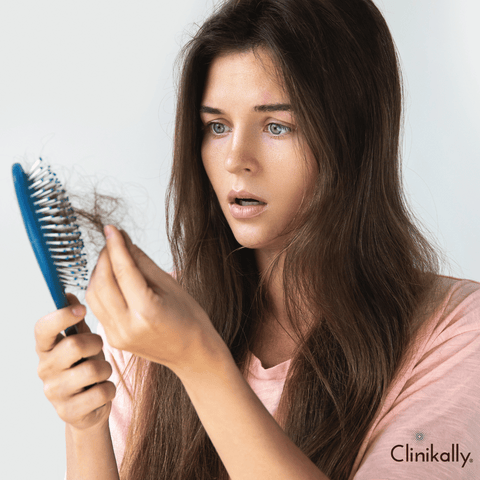
The emotional and psychological impact of hair loss, particularly in women suffering from conditions such as Alopecia Areata, can be profound and multifaceted. Here are some of the emotional and psychological effects of hair loss on women:
-
Self-Esteem and Body Image: Hair loss can have a significant impact on a woman's self-esteem and body image. Many people associate hair with identity and femininity, and losing it can lead to feelings of diminished attractiveness and self-worth.
-
Anxiety and Depression: Hair loss can cause anxiety, depression, and social withdrawal. Women may feel more self-conscious, fearing judgement or negative perceptions from others.
-
Impact on Relationships: Hair loss can have an impact on relationships, including intimate partnerships, friendships, and family interactions. Women may be concerned about how others, including loved ones, perceive them.
-
Social Stigma and Discrimination: Because hair loss is visible and often noticeable, it can result in feelings of stigma or discrimination. Women may face societal pressure or encounter negative attitudes that have an impact on their social interactions.
-
Loss of Control: Women who experience sudden or unpredictable hair loss may feel a loss of control over their appearance and lives. This lack of control can exacerbate distress and frustration.
-
Adapting to Changes: Coping with changes in appearance and adapting to new styling techniques or hair-related accessories can be difficult. Women may struggle to find effective methods of managing or concealing hair loss.
-
Impact on Daily Life: Dealing with hair loss can have an impact on many aspects of daily life, from personal grooming routines to clothing styles that accommodate changes in appearance.
-
Seeking Support and Coping Strategies: Finding support from healthcare professionals, support groups, friends, or family members can be extremely beneficial. Developing coping strategies, practising self-care, and experimenting with different styling options or treatments can help manage the emotional impact.
Alopecia Areata treatment options
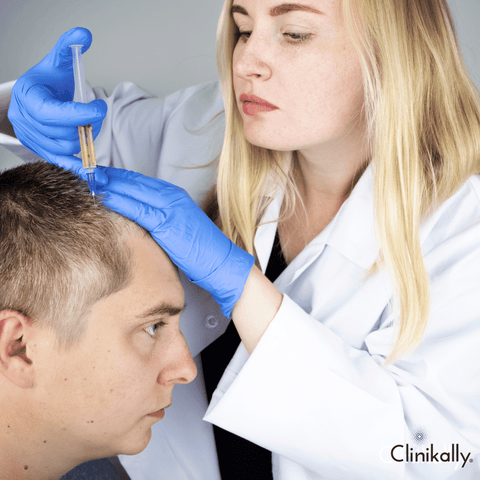
The goals of alopecia areata treatment are to control the condition's course, promote hair growth, or slow down hair loss. Individual differences may exist in the efficacy of treatments, and certain people may recover on their own without assistance. Alopecia areata treatment options include:
-
Topical corticosteroids: Corticosteroids are a type of anti-inflammatory medication that can be applied directly to the scalp to help stimulate hair growth.
-
Injections: Corticosteroid injections may also be used to help stimulate hair growth in people with alopecia areata.
-
Topical minoxidil: Minoxidil is a medication that is applied directly to the scalp and is effective in stimulating hair growth in some people with alopecia areata.
-
Light therapy: Some studies have shown that phototherapy, or light therapy, may help treat alopecia areata.
-
Immunosuppressants: In severe cases of alopecia areata, immunosuppressant medications may be used to suppress the immune system and help promote hair growth.
It's crucial to speak with a medical expert, ideally a dermatologist who specialises in hair issues, to choose the best course of action depending on a variety of personal preferences, age, general health, and the degree of hair loss. The effectiveness of treatments varies, and some may need to be used consistently and with patience before showing any significant effects.
How to stop Alopecia Areata from spreading
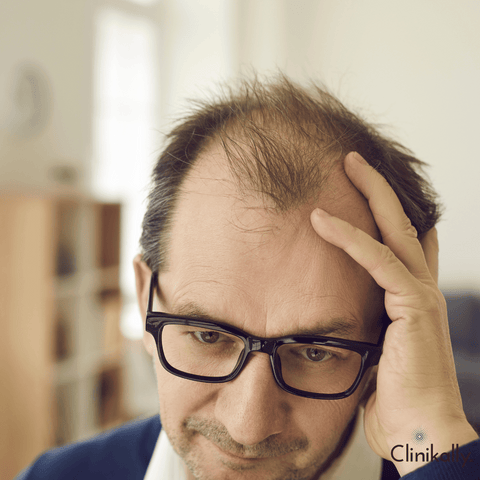
While there is no sure-fire way to prevent alopecia areata from spreading, there are some things that you can do to reduce your risk
-
Avoid harsh hairstyles: Tight ponytails, braids, and other hairstyles that pull on the hair can cause hair loss and potentially worsen alopecia areata.
-
Avoid heat styling: Using hot tools, such as curling irons and hair dryers, can damage the hair and potentially make alopecia areata worse.
-
Avoid chemical treatments: Chemical treatments, such as hair dyes and relaxers, can damage the hair and potentially make alopecia areata worse.
-
Manage stress: While it is not clear if stress directly causes alopecia areata, managing stress through techniques such as meditation, exercise, or therapy may help to reduce the risk of the disorder worsening.
Alopecia Areata Doctor
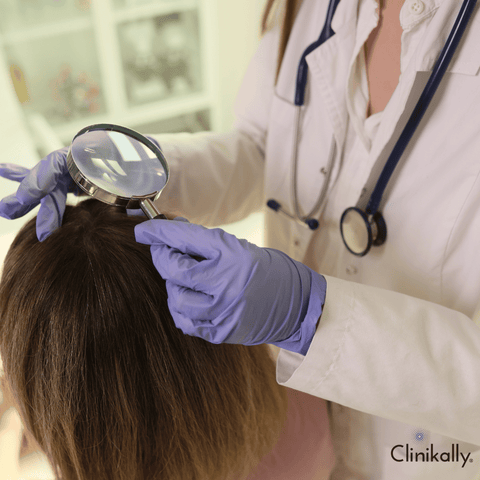
If you are experiencing hair loss and suspect that you may have alopecia areata, it is important to see a doctor. A dermatologist, a doctor who specialises in skin conditions, is usually the best type of doctor to see for alopecia areata. The dermatologist will examine your scalp and possibly do a biopsy to confirm the diagnosis.
How can I cure my Alopecia Areata
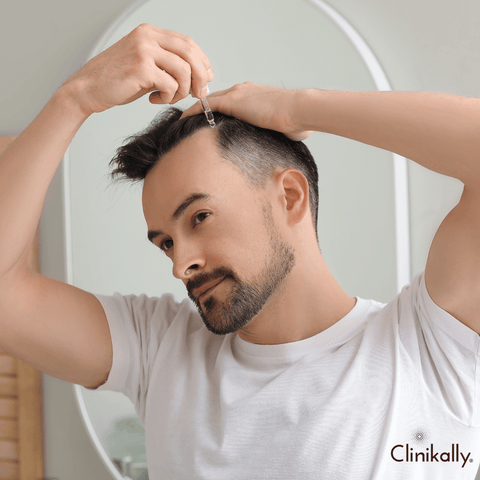
It is important to note that there is currently no known cure for alopecia areata. While some people may experience spontaneous remission or a sudden return of hair growth, for most people with alopecia areata, the condition is chronic and requires ongoing treatment. However, this does not mean that you cannot manage your alopecia areata and achieve good results with treatment. Many people with alopecia areata can achieve significant hair regrowth with the right treatment plan.
Things to avoid when you have Alopecia Areata
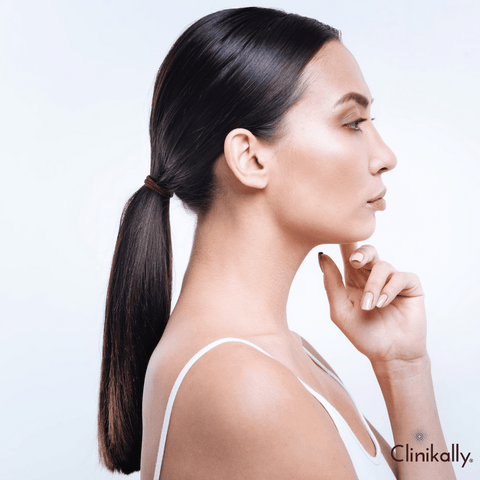
Alopecia areata can be made worse by specific things or behaviours, which can also make treatment less successful. The following are items to think about avoiding:
-
Avoid picking at or scratching your scalp: Picking at the scalp or scratching can cause further hair loss and potentially worsen alopecia areata.
-
Avoid tight hairstyles: As mentioned earlier, tight hairstyles that pull on the hair can cause hair loss and potentially worsen alopecia areata.
-
Avoid harsh hair care products: Using harsh hair care products, such as those that contain sulphates and alcohol, can damage the hair and potentially make alopecia areata worse.
Recall that alopecia areata is a complicated disorder with individual differences in causes and reactions. While some lifestyle changes may help control the disease or enhance general health, it's important to speak with a healthcare provider for individualised advice and therapy catered to your unique circumstances.
How do You deal with Alopecia Areata?
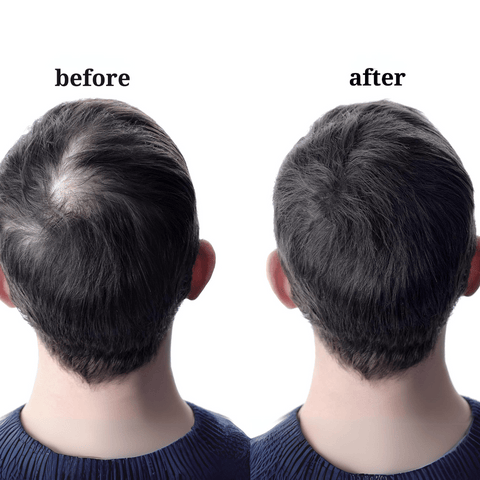
Dealing with alopecia areata can be emotionally challenging, as hair loss can be distressing and can affect self-esteem. However, it is important to remember that alopecia areata is a medical condition that is not your fault and that it does not define you as a person. Here are some tips for managing alopecia areata:
-
Seek support: It can be helpful to talk to others who are also dealing with alopecia areata or to seek support from a therapist or support group.
-
Explore treatment options: Work with your dermatologist to explore treatment options and find a treatment plan that works for you.
-
Embrace your appearance: While it can be difficult, try to embrace your appearance and focus on the things that make you unique and special.
Emerging treatments and therapies for Alopecia Areata
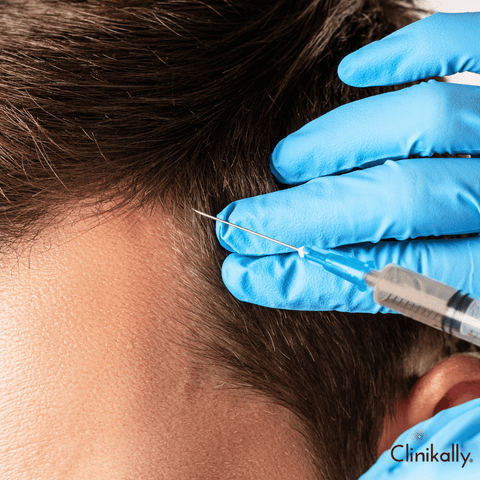
Here are some of the new treatments and therapies for Alopecia Areata:
-
JAK Inhibitors: Janus kinase (JAK) inhibitors have shown promise as a treatment for Alopecia Areata by focusing on specific immunological pathways linked to the disease. The efficacy of medications such as tofacitinib and ruxolitinib, which are typically prescribed for other ailments such as rheumatoid arthritis, in encouraging hair growth has been studied.
-
Biologics: Biologic drugs are being investigated, particularly those targeting specific cytokines or immune pathways involved in Alopecia Areata. Some biologics, such as ustekinumab (used to treat conditions such as psoriasis), are being researched for their potential use in treating Alopecia Areata.
-
Stem Cell Therapy: Research into the use of stem cells for hair regrowth in Alopecia Areata is ongoing. Stem cell therapy is intended to regenerate hair follicles and promote hair growth. Techniques that use adipose-derived stem cells or mesenchymal stem cells are being researched.
-
Topical Immunotherapy: Topical immunotherapy involves applying certain substances (such as diphencyprone or squaric acid dibutylester) to the scalp to elicit an allergic reaction. This reaction could alter the immune response in the affected area, encouraging hair growth.
-
Platelet-Rich Plasma (PRP) Therapy: PRP therapy involves injecting a patient's platelet-rich plasma derived from their blood into the scalp. It is believed to stimulate hair follicles and encourage hair regrowth.
-
Gene Therapy: In preclinical studies, gene editing techniques such as CRISPR-Cas9 are being investigated to modify the genes associated with Alopecia Areata. This method seeks to correct genetic mutations that contribute to the condition.
-
Laser Therapy: Low-level laser therapy (LLLT) or red light therapy is being studied as a non-invasive treatment option for stimulating hair follicles and promoting hair regrowth in Alopecia Areata.
-
Psychological Support and Behavioural Therapies: Because hair loss has a psychological impact, various therapies and support programmes are being developed to address the emotional and mental health aspects of Alopecia Areata.
While these treatments have promise, they are not all widely available or approved for Alopecia Areata treatment. Furthermore, individual responses to these treatments can vary, necessitating additional research to determine their long-term efficacy and safety.
What is the Fastest Way to Cure Alopecia Areata?

As mentioned earlier, there is currently no known cure for alopecia areata. While some people may experience spontaneous remission, for most people with alopecia areata, the condition is chronic and requires ongoing treatment. However, this does not mean that you cannot manage your alopecia areata and achieve good results with treatment. Many people with alopecia areata can achieve significant hair regrowth with the right treatment plan.
In conclusion, alopecia areata is an autoimmune disorder that causes hair loss on the scalp and other areas of the body. It is believed to be caused by a combination of genetic and environmental factors, and can range from a small patch of hair loss to complete baldness. While there is currently no known cure for alopecia areata, many people with the condition can achieve good results with treatment. If you are experiencing hair loss and suspect that you may have alopecia areata, it is important to see a dermatologist for a proper diagnosis and treatment plan.
Evaluating the effectiveness of rapid treatment options
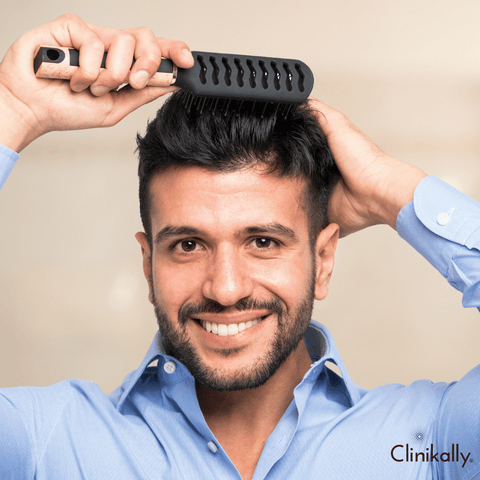
Rapid treatment options in skincare frequently promise quick results, but their effectiveness can vary depending on a variety of factors, including:
-
Ingredients and Formulation: Most rapid treatment products contain active ingredients that provide immediate visible results. Look for hydrating ingredients like hyaluronic acid, retinoids for skin renewal, and vitamin C for brightening.
-
Targeted Issues: Various rapid treatments address specific skincare issues. For example, products marketed as instant hydrators may temporarily plump the skin, whereas others claiming instant brightening may contain ingredients that provide immediate radiance.
-
Individual Skin Response: Not all rapid treatments are equally effective for everyone. Skin type, sensitivity, and pre-existing skin conditions can all have an impact on how well the product performs and whether it causes any adverse reactions.
-
Consistency and Long-Term Effects: While some rapid treatments provide immediate visible improvements, their long-term benefits may necessitate consistent use over time. For example, while a face mask may provide immediate hydration, using it regularly may result in long-term improvements in skin texture and moisture levels.
-
Product Claims vs. Realistic Expectations: Exaggerated claims should be avoided. While some products may produce noticeable results quickly, others may require more time to produce significant results. Manage your expectations and recognise that skincare is often a gradual process.
-
Professional Recommendations: Speaking with a dermatologist or skincare professional can help you find the best rapid treatment options for your specific skin concerns and needs. They can make recommendations for effective treatments or procedures based on your skin type and condition.
-
Patch Testing and Allergies: Before applying new products or treatments to your entire face, always perform patch tests to check for any adverse reactions or allergies.
While quick-fix treatments might produce noticeable results quickly, their efficacy can vary based on some factors, including formulation, individual skin response, and reasonable expectations. For optimal effects, pick items with dependable active ingredients, comprehend their function, and follow the directions. Speaking with skincare specialists can help you make informed decisions about which quick and efficient treatments to choose for your skincare issues.









































